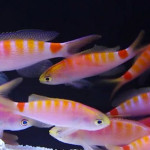Monthly Archives: November 2013

Tip of the Week # 9, Display Tank Black-outs
A while back I had started reading about fellow hobbyists completing a 3 day black out on their reef tanks every 3 months as a part of their routine maintenance. Starting about 6 months ago, I started blacking out my reef tank for 3 days every two months. There was no harmful effects to my SPS corals or my carpet anemone.
Some of the Identified Benefits Include:
-Slowing down algae growth
-Very effective to help get rid of cyano when used with other traditional control methods
-When done right, it can add a part of a natural cycle as seen in nature as it can simulate a bid storm without some of the negative effects
-In certain set-ups, it will help to slowly reduce the nitrates and phosphates as the inhabitants would experiences a slowed down metabolism allowing the nutrient removal processes in the aquarium to have a greater impact.
Some Tips for Best Results:
-Only turn off the tank lighting. Allow the ambient room light to hit the tank so you can feed your fish
-Keep all other equipment running on the set-up.
-Feed you fish about ¼ to 1/3 of the normal amount during the black-out period.
-On smaller tanks, carefully watch your pH levels as the level could drop very low in smaller set-up
-The approach works very well on set-up with refugium or algae scrubbers if you leave the lighting schedule the same for the refugium and algae scrubber
-Complete a larger than normal water change after the blackout due to any algae die-off can release extra nutrients into the water.
-Return to your normal lighting level slowly as to not shock any of your corals and/or anemones
-BTAs can start to move during a black-out period
-This will only temporarily solve algae problems. Without removing the cause(s) of the algae, it will come back in time.
Some other references for routine aquarium maintenance:
https://www.reefaquarium.com/2012/marine-aquarium-maintenance/

Tip of the Week # 8, Stocking Tangs
The one aspect about stocking marine aquariums that I have found the most conflicting information on is what is a proper stocking plan when keeping tangs. A part of the problem is the amount of variation between maximum sizes, growth rates, and the temperament / personality of the fish. I have personally seen yellow tangs reaching a maximum size 10 inches and other reaching a maximum size of about 14 inches, both being kept in set-up that would allow for more growth.
So what is the right answer ?
- Do your homework, get as much first hand information from trustworthy people as possible.
- If you are new to marine aquariums, error on the side of caution and get a aquarium that is a little larger than what you could stock your tang in.
- Use extreme caution when keeping multiple tangs in one aquarium in numbers less than 5.
- Always watch carefully for signs that your current stocking is not working out in the best interests of the fish.
The below links will provide you with some further information to help you understand this better
https://www.reefaquarium.com/2013/responsible-fish-keeping/
http://coralmagazine-us.com/content/arrested-tang-police-i-refuse-confess
http://microcosmaqx.typepad.com/jay_hemdal/2009/01/beware-the-tang-police.html
http://www.tfhmagazine.com/saltwater-reef/feature-articles/putting-fish-back-into-the-reef-tank.htm

Tip of the Week # 7 – Skimmer Capasity
Manufacture ratings should always be considered as guidelines and never hard fast rules. In my opinion, almost all of these capacities are over rated. The reason for my opinion is that manufactures typically complete their product testing with the gate valve and air valve(s) wide open to calculate the maximum flow rate and maximum air intake using these measurements to calculate the maximum rated capacity for the skimmer. As we all know, the gate valve and air valve(s) will need to be adjusted in order for the skimmer to work properly which will also lower both the flow rate and air intake of the skimmer from the manufacture’s measurements. This is why many hobbyist prefer to use skimmers that have a much higher rated maximum capacity than their aquarium.
The below link can help you determine how to pick out a skimmer for your set-up
https://www.reefaquarium.com/2013/selecting-a-new-skimmer/
And the below will offer you some other ways to evaluate potential skimmers
http://www.advancedaquarist.com/2010/1/aafeature
And some interesting skimmer information
http://reefbuilders.com/2012/12/20/protein-skimmers-function/
http://reefbuilders.com/?s=skimmers

Tip of the Week # 6 – Carbon Dosing
If you are planning to use carbon dosing to reduce high levels of nitrates and/or phosphates, please keep in mind you need to start off slowly and at a very low level. Making quick and drastic changes to your nitrate levels through all/any forms of carbon dosing will cause your water parameters to become at least somewhat unstable. Take it very slow to begin with allowing your system to slowly adjust over time. You have to always keep in mind, only bad things will happen fast in this hobby.
More information about carbon dosing can be found in the below article:
https://www.reefaquarium.com/2012/carbon-dosing-in-laymans-terms/
And a few other articles about carbon dosing

Watch video of new Caledonia Sunrise Anthias
The New Caledonia Sunrise Anthias is a stunning new species that we recently wrote about here. The species is allready being collected and can be purchased in the United states through Quality Marine. Quality Marine is bringing in a decent number of these stunning fish and you should be able to pick up a group of them at a decent price.
The clip below will tell you more about this species, how it was discovered and will let you see it in both the wild and in an aquarium environment:

Tip of the Week # 5 – Fish Compatibility
Sometimes you can thoroughly complete your research to ensure the best possibly compatibility between all of your fish, but you sometimes will just end up with all kinds of problems. The reason for this is that fish can also have their very own unique and individual personalities. And just like people, you can find miserable , grumpy, and mean fish that are completely different the average fish of the exact same species. Although I would think this is a very small percentage, it is still a risk.
This is why I always recommend that you keep a very close eye on your aquarium every time you add a new fish to the set-up. Even when you quarantine a new fish for 4 or 5 weeks, you may still not know with 100% certainty how well this will work out until you add them.
The below link and also offer a few guidelines to help you think through determining appropriate stocking for your aquarium
https://www.reefaquarium.com/2013/responsible-fish-keeping/
The below link can also offer you some good ideas about stocking butterflys in reef set-ups
http://reefbuilders.com/2013/10/29/keeping-butterflyfish-reefs-avoid/